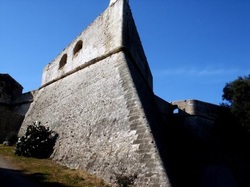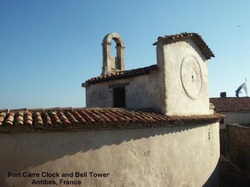

 11 February ’05, Friday. Fort Carré, Antibes It’s amazing how fast the weeks go by… We have kind of slowed down our “journey” since arriving in Antibes, so there isn’t the constant “new” ancient sites that I can cover in the journal. Now that I’ve said that, we did take in Fort Carré in Antibes. We have walked by it a number of times since we arrived, and finally on Wednesday, we decided it was time. We walked almost completely around it before we found the entrance and when we did, we found that we had to have a guided tour. It would be another 15 minutes before the next one. It was a fast 15 minutes before the young lady came out and directed us through the gate. As it was, Louise and I were the only people on the tour… another good reason to travel in the winter… Our tour was nice, but short…(I think she had a date waiting for her in the office that she wanted to get back too). The “Fort” was really an interesting piece of architecture. It was built on a small peninsula just across a small inlet from Antibes. In the center of the structure was a chapel, living quarters for the officers and non-officers, and the tower for the church, clock, and pigeon quarters.  This was a circular building of 3 floors. The rest of the fort was built into a 4 star “bastion” spreading out from the center. Long before Christianity, this was a place of a Roman cult with a temple dedicated to the god Mercury. As Christianity spread, this became the site for one of the first churches of the area. In 1550, King Henry II had the fort built for the defenses of the area and was completed in 1588 under Henry III. It was never fired upon, but did have some interesting “defensive” architectural designs. One was to keep the rats from coming off the waterfront and infesting the interior, and the other was the slope and the angles of the exterior walls. As far as the rats, there was a small rounded protrusion that came out from the walls about ¾’s of the way up that the rats couldn’t climb over. The other, being the slope and angles of the walls, were built so that when a cannon ball was to hit the wall, it would glance off the wall with no damage to the structure. Unfortunately (or maybe fortunately) it never got tested… Other than that, we have stayed close to home, with long walks through the local parks and around the village.
0 Comments
Leave a Reply. |
*Locations*
All
*Archives*
November 2016
|
